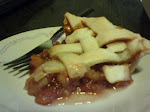 The kiwifruit, often shortened to just "kiwi" in many parts of the world is an edible berry. The most common kiwifruit is oval and about the size of a large hen's egg. It has a fibrous, dull brown-green skin and bright green or golden flesh with rows of tiny, black, edible seeds. ~~~ Kiwifruit is a rich source of Vitamin C. Its Potassium content by weight is slightly less than that of a banana. It also contains Vitamin E and a small amount of Vitamin A. The skin is a good source of flavonoid antioxidants. The kiwifruit seed oil contains on average 62% alpha-linolenic acid, an omega-3 fatty acid. ~~~ Raw kiwifruit is also rich in the protein-dissolving enzyme actinidin, which is commercially useful as a meat tenderizer. Actinidin also makes raw kiwifruit unsuitable for use in desserts containing milk or any other dairy products which are not going to be served within hours, because the enzyme soon begins to digest milk proteins. This applies to gelatin-based desserts as well, as the actinidin will dissolve the collagen proteins in gelatin very quickly, either liquifying the dessert, or preventing it from solidifying. Some cooks suggest cooking the fruit for a few minutes before adding it to the gelatin to overcome this effect. ~~~ Its numerous edible seeds have potential properties of a natural blood thinner. A study reported consuming two to three kiwifruit daily for 28 days significantly reduced platelet aggregation and blood triglyceride levels (similar to popular mainstream aspirin therapy), potentially reducing the risk of blood clots. So slice yourself some kiwi and enjoy its many healthful benefits.
The kiwifruit, often shortened to just "kiwi" in many parts of the world is an edible berry. The most common kiwifruit is oval and about the size of a large hen's egg. It has a fibrous, dull brown-green skin and bright green or golden flesh with rows of tiny, black, edible seeds. ~~~ Kiwifruit is a rich source of Vitamin C. Its Potassium content by weight is slightly less than that of a banana. It also contains Vitamin E and a small amount of Vitamin A. The skin is a good source of flavonoid antioxidants. The kiwifruit seed oil contains on average 62% alpha-linolenic acid, an omega-3 fatty acid. ~~~ Raw kiwifruit is also rich in the protein-dissolving enzyme actinidin, which is commercially useful as a meat tenderizer. Actinidin also makes raw kiwifruit unsuitable for use in desserts containing milk or any other dairy products which are not going to be served within hours, because the enzyme soon begins to digest milk proteins. This applies to gelatin-based desserts as well, as the actinidin will dissolve the collagen proteins in gelatin very quickly, either liquifying the dessert, or preventing it from solidifying. Some cooks suggest cooking the fruit for a few minutes before adding it to the gelatin to overcome this effect. ~~~ Its numerous edible seeds have potential properties of a natural blood thinner. A study reported consuming two to three kiwifruit daily for 28 days significantly reduced platelet aggregation and blood triglyceride levels (similar to popular mainstream aspirin therapy), potentially reducing the risk of blood clots. So slice yourself some kiwi and enjoy its many healthful benefits. 
~ Chef ~










































